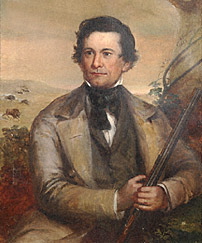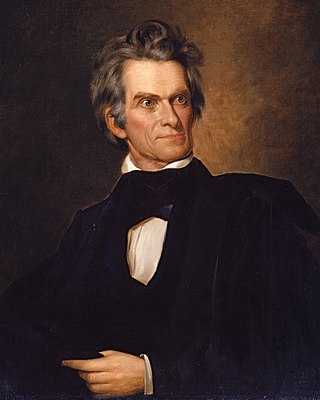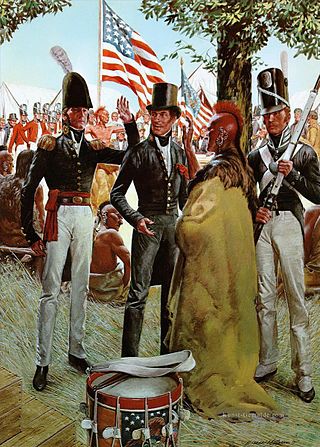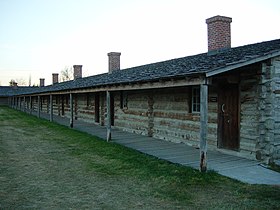
Washington County is a county in the U.S. state of Nebraska. As of the 2020 United States Census, the population was 20,865. Its county seat is Blair.

The Territory of Nebraska was an organized incorporated territory of the United States that existed from May 30, 1854, until March 1, 1867, when the final extent of the territory was admitted to the Union as the state of Nebraska. The Nebraska Territory was created by the Kansas–Nebraska Act of 1854. The territorial capital was Omaha. The territory encompassed areas of what is today Nebraska, Wyoming, South Dakota, North Dakota, Colorado, and Montana.

The Arikara War was an armed conflict between the United States, their allies from the Sioux tribe and Arikara Native Americans that took place in the summer of 1823, along the Missouri River in present-day South Dakota. It was the first Indian war west of the Missouri fought by the U.S. Army and its only conflict ever with the Arikara. The war came as a response to an Arikara attack on trappers, called "the worst disaster in the history of the Western fur trade".

Stephen Harriman Long was an American army civil engineer, explorer, and inventor. As an inventor, he is noted for his developments in the design of steam locomotives. He was also one of the most prolific explorers of the early 1800s, although his career as an explorer was relatively short-lived. He covered over 26,000 miles in five expeditions, including a scientific expedition in the Great Plains area, which he famously confirmed as a "Great Desert".

Arikara, also known as Sahnish, Arikaree, Ree, or Hundi, are a tribe of Native Americans in North Dakota. Today, they are enrolled with the Mandan and the Hidatsa as the federally recognized tribe known as the Mandan, Hidatsa, and Arikara Nation.

Henry Atkinson was a United States army officer serving on the western frontier, during the War of 1812, and the Yellowstone expedition. With Indian agent Benjamin O'Fallon, he negotiated a treaty with Native Americans of the upper Missouri River in 1825. Over his career in the army, he served in the western frontier, the Gulf Coast, and in New York at the border with Canada.

Fort Abraham Lincoln State Park is a North Dakota state park located 7 miles (11 km) south of Mandan, North Dakota, United States. The park is home to the replica Mandan On-A-Slant Indian Village and reconstructed military buildings including the Custer House.
Cabanne's Trading Post was established in 1822 by the American Fur Company as Fort Robidoux near present-day Dodge Park in North Omaha, Nebraska, United States. It was named for the influential fur trapper Joseph Robidoux. Soon after it was opened, the post was called the French Company or Cabanné's Post, for the ancestry and name of its operator, Jean Pierre Cabanné, who was born and raised among the French community of St. Louis, Missouri.

Colonel Josiah Snelling was the first commander of Fort Snelling, a fort located at the confluence of the Mississippi and Minnesota rivers in Minnesota. He was responsible for the initial design and construction of the fort, and he commanded it from 1820 through 1827. He had a reputation for being tough and fair-minded, but also had a mean temper when he was drunk. His second wife, Abigail Hunt Snelling, extended hospitality to visitors to the fort. She also founded a Sunday School for the fort's children and assisted families from the Red River Colony.

Fontenelle's Post, first known as Pilcher's Post, and the site of the later city of Bellevue, was built in 1822 in the Nebraska Territory by Joshua Pilcher, then president of the Missouri Fur Company. Located on the west side of the Missouri River, it developed as one of the first European-American settlements in Nebraska. The Post served as a center for trading with local Omaha, Otoe, Missouri, and Pawnee tribes.
Fort Lisa (1812–1823) was established in 1812 in what is now North Omaha in Omaha, Nebraska by famed fur trader Manuel Lisa and the Missouri Fur Company, which was based in Saint Louis. The fort was associated with several firsts in Nebraska history: Lisa was the first European farmer in Nebraska; it was the first settlement by American citizens set up in the then-recent Louisiana Purchase; Lisa's wife was the first woman resident of European descent in Nebraska; and the first steamboat to navigate Nebraska waters, the Western Engineer, arrived at Fort Lisa in September 1819.
Nanza is the Ponca name for what is now called Ponca Fort. It was a fortified village built by the Ponca in the vicinity of present-day Niobrara, Nebraska, USA, in circa 1700 and occupied until about 1865.

Fort Belle Fontaine is a former U.S. military base located in St. Louis County, Missouri, across the Mississippi and Missouri rivers from Alton, Illinois. The fort was the first U.S. military installation west of the Mississippi, in the newly acquired Louisiana Territory, and served as a starting point for many expeditions to the American West.

Peter Abadie Sarpy (1805–1865) was the French-American owner and operator of several fur trading posts, essential to the development of the Nebraska Territory, and a thriving ferry business. A prominent businessman, he helped lay out the towns of Bellevue and Decatur, Nebraska. Nebraska's legislature named Sarpy County after him in honor of his service to the state.

The Yellowstone expedition was an expedition to the American frontier in 1819 and 1820 authorized by United States Secretary of War John C. Calhoun, with the goal of establishing a military fort or outpost at the mouth of the Yellowstone River in present-day North Dakota. Sometimes called the Atkinson–Long Expedition after its two principal leaders, Colonel Henry Atkinson and Major Stephen Harriman Long, it led to the creation of Fort Atkinson in present-day Nebraska, the first United States Army post established west of the Missouri River, but was otherwise a costly failure, stalling near Council Bluffs, Iowa.

French people have been present in the U.S. state of Nebraska since before it achieved statehood in 1867. The area was originally claimed by France in 1682 as part of La Louisiane, the extent of which was largely defined by the watershed of the Mississippi River and its tributaries. Over the following centuries, explorers of French ethnicity, many of them French-Canadian, trapped, hunted, and established settlements and trading posts across much of the northern Great Plains, including the territory that would eventually become Nebraska, even in the period after France formally ceded its North American claims to Spain. During the 19th century, fur trading gave way to settlements and farming across the state, and French colonists and French-American migrants continued to operate businesses and build towns in Nebraska. Many of their descendants continue to live in the state.

Engineer Cantonment is an archaeological site in Washington County, in the state of Nebraska in the Midwestern United States. Located in the floodplain of the Missouri River near present-day Omaha, Nebraska, it was the temporary winter camp of the scientific party of the Yellowstone Expedition. From October 1819 to June 1820, the party studied the geology and biology of the vicinity, and met with the local indigenous peoples. Their eight-month study of the biota has been described as "the first biodiversity inventory undertaken in the United States".

The Stephen H. Long Expedition of 1820 traversed America's Great Plains and up to the foothills of the Rocky Mountains. It was the first scientific party hired by the United States government to explore the West. Lewis and Clark (1803–1806) and Zebulon Pike (1805–1807) explored the western frontier but they were primarily military expeditions. A group of scientists traveled to St. Louis and on to Council Bluff (Nebraska) for the Yellowstone expedition of the upper Missouri River that would have established a number of military posts. The expensive effort was cancelled following a financial crash, steamboat failures, operational scandals, and negotiation of the Adams–Onís Treaty of 1819, which changed the border between New Spain and the United States. The scientists were reassigned to an expedition led by Stephen Harriman Long. From June 6 to September 13, 1820, Long and fellow scientists traveled across the Great Plains beginning at the Missouri River near present Omaha, Nebraska, along the Platte River to the Front Range, and east along the Arkansas and Canadian Rivers of Colorado and Oklahoma. The expedition terminated at Fort Smith in Arkansas. They recorded many new species of plants, insects, and animals. Long termed the land the Great American Desert.

Benjamin O'Fallon (1793–1842) was an Indian agent along the upper areas of the Mississippi and Missouri Rivers. He interacted with Native Americans as a trader and Indian agent. He was against British trappers and traders operating in the United States and territories. He believed that the military should have taken a strong stance against the British and firm in negotiations with Native Americans. Despite his brash manner and contention with the military, he was able to negotiate treaties between native and white Americans. In his early and later careers, he built gristmills, was a retailer, and a planter. He collected Native American artifacts and paintings of tribe members by George Catlin. His uncle William Clark was his guardian and financial backer.

The paddle steamer Western Engineer was the first steamboat on the Missouri River. It was purpose built after a design by Major Stephen Harriman Long by the Allegheny Arsenal in Pittsburgh, for the scientific party of the Yellowstone expedition which Major Long commanded. The paddle wheel was placed in the stern, the steam engine hidden below the waterline, the vessel was heavily armed and had acquired a peculiar appearance intended to inspire fear and awe among the Plains Indians. Her first voyage took her from Pittsburgh to Saint Louis in 1819. The second voyage took her to Fort Lisa, Nebraska the same year. The third voyage took her back to Saint Louis in the spring of 1820, while the fourth voyage was a charting expedition up the Mississippi to the Des Moines Rapids and down to Cape Girardeau, Missouri. A fifth voyage supposed to take her back to Pittsburgh had to be aborted at Smithland, Kentucky due to low water, and she was left there.



















